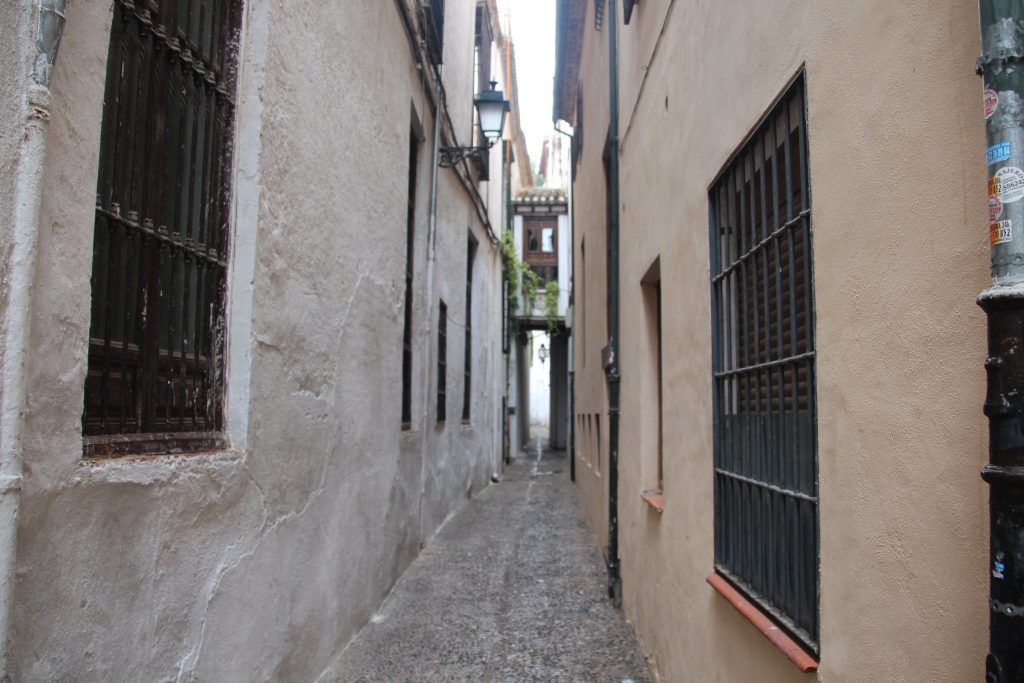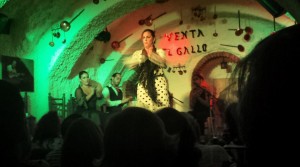September 28th
This post covers our two days in Granada.
We weren’t too sure how this part of our trip was going to go when we got a message late Friday evening that our hotel had a problem with our room and we would not be able to stay there. We weren’t to worry, however, because they booked another hotel for us. That did not sound good. Then, after we got in the queue to get on the train this morning, we were told that the train wasn’t going. We weren’t to worry however, because we could get on another train and they would arrange a bus to get us to Granada. The new train was one of the fast ones and the trip to Antequera was fast. The bus for the last 60 miles was not fast. When we got to Granada, there was a dearth of taxis for the 75 or 80 people who needed one. When we got a taxi, the driver spoke only Spanish and I wasn’t sure if he understood my directions. Finally after driving on a succession of smaller and smaller streets, he stuck his arm out the window and said aqui. But there was no here at this aqui. Only a bunch of stone steps headed up the hill. Aqui, Aqui. So I went up the hill, hunted around for a while, asked for directions, and found an unlabeled door which seemed to be at the right address. This is not going to turn out well, I thought. When we hauled our luggage up we were met at the door by Raul. He took us inside and we found a nice arabic-style 7-room “carmen” which is like a B&B or a riad in Morocco. The building dates back to the 1100s and was renovated in the 1500s and has been updated to its current purpose much more recently. Our room was small, but not uncomfortable.
After settling in a bit, we walked around the Albiacin area a little bit. The streets are so narrow that when a car comes by the pedestrians have to crowd against the walls to get out of the way. We found a place to get tapas and found gelato for desert. There was quite a bit of activity because this is a three-day weekend for some people.
In the evening, we went out to see a flamenco show in the Sacromonte district of Granada. In Sacromonte, a number of the flamenco shows are held in caves, where the Roma (they call them gypsies here) lived. It was pretty touristy, but we had a good time. The music and dancing were good. As a “special attraction,” there was a 10- or 11-year old girl who, while clearly still learning, was already good. We got back about 1:00 in the
morning, which made our 6:30 alarm seem pretty early.
The buffet breakfast at Carmen del Cobertizo (a “carmen” is the style of this kind of house and cobertizo is a little covered bridge. The covered bridge is attached to our room) was simple and we finished with what we thought was plenty of time to get to our Alhambra tour’s start. We were wrong. My receipt for the tour said it began at 10:00. I received an email Saturday afternoon saying we needed to be at the start point by 9:00. Our host was puzzled by the contradiction so he called the tour company at about 9:10. They said we were already late and had 10 minutes to get there. We rushed from the hotel to Plaza Nueva, where there are taxies, and raced up the hill to the tour start location. When we got there, we were told that the tour would start in 10 minutes. Less than a minute later, the tour took off. By this point, we were a little irritated by the confusion and the need to rush, but the tour of the Alhambra quickly got rid of those thoughts. [We never did find out what happened with the time.]
The Alhambra is a fortress and palace complex that includes gardens that were to be a “paradise on earth.” The original fort was built in 889, was expanded in the 1100s, and
became a royal palace in the early 1300s. All of that work was done by Moorish rulers because the Moors were in control of the area for hundreds of years. After 1492 (the “reconquest”) some Christian rulers lived there and started a new palace. Fortunately, the Christians did not destroy all of the beauty the Moors had built.
We were with 10 other people on the tour so we were able to hear everything and to ask lots of questions. The Alhambra and its gardens cover a lot of space and the tour, which lasted a little longer than 3 hours, took us to many locations but the tour could only touch on the wonders of the Alhambra. We have seen other Moorish work and it it was easy for us to see that the Alhambra was/is a fusion of styles. A lot of local stone was used in its construction and the building walls have a reddish cast. Most of the decoration is inside the buildings and consists of calligraphy, geometric patterns and typical Moorish stucco and cement work similar to some of what we saw in Morocco. 40,000 people lived inside the walls and to support them there was a large and sophisticated water supply, vegetable gardens, and an extensive network of roads. The roads are paved (if that is the right word) with stones from the local river. That makes them easy for horses, but they can be a little rough for people. The Alhambra complex was abandoned for hundreds of years and squatters lived there–with their animals–for a long time. In 1810 the French did a good bit of damage while occupying the grounds. You can still see dents from cannon balls in some of the walls. During the 1800s several writers and artists wrote about the Alhambra (Washington Irving, for example, wrote “Tales of the Alhambra”) and people began to visit in larger numbers. Restorations began and our guide told us that about 40% has been more-or-less completely restored.
We visited the palaces, the gardens, the summer house (whose garden was the inspiration for some of De Falla’s music), and we spent time looking at the Alhambra and the town of
Granada below from various viewpoints. Because it was Sunday, we could hear bells from all over. There was a great deal to take in and we would like to see more, but 3.5 hours is about as much as we could absorb at one time.
We took pictures and I have posted some of them on the pictures page, but as with so many of the places we have visited, pictures can only give an idea of the scale, color, and beauty of a place.
As we walked up to the Summer Palace it began to rain. By the time we finished the tour it was raining hard. The rain did not spoil the tour and the guide told us the rain was badly needed. We took the tour company’s bus back down the hill and made our way back to Plaza Nueva.
We had a very pleasant lunch in a small resturant off the plaza where we tried some of the local food and drank some of the local wine and beer. We almost out-lasted the rain but not quite. We arrived back at our “carmen” a little damp and a little tired, but completely satisfied with our day. We ate enough for lunch that I think we’ll only need gelato this evening.
An evening update: we did go out in the evening. In addition to gelato, we found a large procession moving down the Grand Via. We also found a group of 5 street performers doing flamenco, both singing and dancing. The procession was in honor of San Miguel. We got there some time after it began and watched it for half an hour and it still had not ended. There were several bands and, I would say, several thousand people with candles in the procession. The flamenco performers were quite good and attracted a large crowd. We watched for almost half an hour and tossed only a couple of euros in the hat which made it considerably less expensive than last night’s entertainment.
We will pack for our next stage tonight: we move on to Sevilla tomorrow.
More pictures on the pictures page.






Kate Jacobs
29 Sep 2014Gosh I’ve always wanted to see the Alhambra! Your post and pictures are fantastic!!